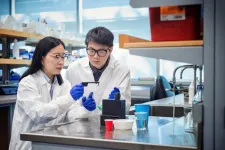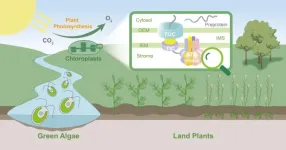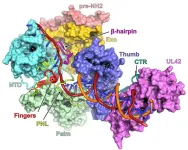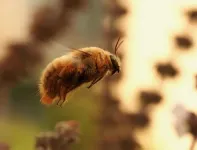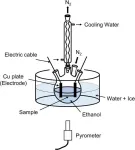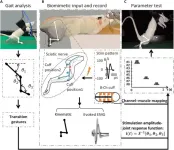(Press-News.org) Micro- and nanoplastics are in our food, water and the air we breathe. They are showing up in our bodies, from testicles to brain matter.
Now, University of British Columbia researchers have developed a low-cost, portable tool to accurately measure plastic released from everyday sources like disposable cups and water bottles.
The device, paired with an app, uses fluorescent labeling to detect plastic particles ranging from 50 nanometres to 10 microns in size – too small to be detected by the naked eye – and delivers results in minutes.
The method and findings are detailed in ACS Sensors.
“The breakdown of larger plastic pieces into microplastics and nanoplastics presents significant threats to food systems, ecosystems, and human health,” said Dr. Tianxi Yang, an assistant professor in the faculty of land and food systems, who developed the tool. “This new technique allows quick, cheap detection of these plastics, which could help protect our health and ecosystems.”
Nano and microplastics are byproducts of degrading plastic materials such as lunchboxes, cups and utensils. As very small particles with a large surface area, nanoplastics are particularly concerning to human health due to their increased ability to absorb toxins and penetrate biological barriers within the human body.
Detecting these plastics typically requires skilled personnel and expensive equipment. Dr. Yang’s team wanted to make detection faster, more accessible and more reliable.
They created a small, biodegradable, 3D-printed box containing a wireless digital microscope, green LED light and an excitation filter. To measure the plastics, they customized MATLAB software with machine-learning algorithms and combined it with image capture software.
The result is a portable tool that works with a smartphone or other mobile device to reveal the number of plastic particles in a sample. The tool only needs a tiny liquid sample – less than a drop of water – and makes the plastic particles glow under the green LED light in the microscope to visualize and measure them. The results are easy to understand, whether by a technician in a food processing lab or just someone curious about their morning cup of coffee.
For the study, Dr. Yang’s team tested disposable polystyrene cups. They filled the cups with 50 mL of distilled, boiling water and let it cool for 30 minutes. The results showed that the cups released hundreds of millions of nano-sized plastic particles, roughly one-hundredth the width of a human hair and smaller.
“Once the microscope in the box captures the fluorescent image, the app matches the image’s pixel area with the number of plastics,” said co-author Haoming (Peter) Yang, a master’s student in the faculty of land and food systems. “The readout shows if plastics are present and how much. Each test costs only 1.5 cents.”
The tool is currently calibrated to measure polystyrene, but the machine-learning algorithm could be tweaked to measure different types of plastics like polyethylene or polypropylene. Next, the researchers aim to commercialize the device to analyze plastic particles for other real-world applications.
The long-term impacts of ingesting plastic from beverages, food, and even from airborne plastic particles are still being studied but show cause for concern.
“To reduce plastic ingestion, it is important to consider avoiding petroleum-based plastic products by opting for alternatives like glass or stainless steel for food containers. The development of biodegradable packaging materials is also important for replacing traditional plastics and moving towards a more sustainable world,” said Dr. Yang.
END
How much microplastic are you drinking? New UBC tool can tell you in minutes
Low-cost, portable tool accurately measures plastic released from everyday sources like disposable cups and water bottles
2024-08-27
ELSE PRESS RELEASES FROM THIS DATE:
Race and ethnicity and diagnostic testing for common conditions in the acute care setting
2024-08-27
About The Study: White patients discharged from the emergency department with a nonspecific diagnosis of interest were significantly more likely than Black patients to receive related diagnostic testing in this study. The extent to which this represents diagnostic test overuse in white patients vs undertesting and missed diagnoses in Black patients deserves further study.
Corresponding Author: To contact the corresponding author, Michael I. Ellenbogen, M.D., email mellenb6@jhmi.edu.
To access the embargoed study: Visit our For The Media website at this link https://media.jamanetwork.com/
(doi:10.1001/jamanetworkopen.2024.30306)
Editor’s ...
Groundbreaking studies provide key insights into chloroplasts protein import motor
2024-08-27
Two groundbreaking studies published in the journal Cell shed light on the assembly, function and evolutionary diversity of the chloroplast protein import system.
Chloroplasts are fundamental organelles in plant cells that act as the primary site of photosynthesis to sustain life on Earth. Although chloroplasts have their own genome, most of their proteins are encoded in the nucleus and synthesized as preproteins in the cytosol. These preproteins are subsequently transported across the outer and inner envelope membranes of the chloroplasts. The translocon machineries, known as the TOC (translocon at the outer chloroplast membrane) and TIC (translocon at ...
What enables herpes simplex virus to become impervious to drugs?
2024-08-27
All organisms — from fungi to mammals — have the capacity to evolve and adapt to their environments. But viruses are master shapeshifters with an ability to mutate greater than any other organism. As a result, they can evade treatments or acquire resistance to once-effective antiviral medications.
Working with herpes simplex virus (HSV), a new study led by Harvard Medical School researchers sheds light on one of the ways in which the virus becomes resistant to treatment, a problem that could be particularly ...
Keeping native bees buzzing requires rethinking pest control
2024-08-27
Whether you’re strolling through a garden, wandering a park, or simply enjoying an open space in the United States, you’re likely to notice bees buzzing about the flowers. While honeybees, imported from Europe in the 17th century to produce honey, are the most recognizable, they aren’t the only bees at work. If you’re a keen observer, you might spot some of the thousands of less familiar, native bee species that call these spaces home.
Native wild bees play a crucial ecological role, ensuring the survival and reproduction of ...
Nanotubes get a boost: Liquid-phase synthesis unlock efficient production
2024-08-27
Single-walled carbon nanotubes (SWCNTs) are known for their remarkable properties, which make them essential in many advanced technologies. Yet, creating these nanotubes efficiently and on a large scale has been a persistent challenge.
Now, a team led by Professor Takahiro Maruyama at Meijo University has introduced a revolutionary method that utilizes cobalt (Co) and iridium (Ir) nanoparticle catalysts in a liquid-phase synthesis process. This innovative approach offers a promising solution to the longstanding issues of production efficiency and scalability. These findings have been published ...
Pregnancy after sterilization turns out to be surprisingly common
2024-08-27
Study led by UCSF estimates 3 to 5% of women have unplanned pregnancies following “permanent” sterilization
Tubal sterilization is thought to be a permanent form of birth control and is the most common method of contraception nationally. But a new study led by UC San Francisco reports that tubal surgery fails often enough that some other forms of birth control are usually more effective.
The authors found that 3 to 5% of women in the United States who had their tubes tied later reported an unplanned pregnancy. This failure rate led the authors to suggest that patients who really want to avoid future pregnancy should instead ...
Mount Sinai Health System researcher receives $4 million grant from NIH to study the role of the mammary gland secretome in metabolic health
2024-08-27
New York, NY (August 27, 2024) – The National Institute of Diabetes and Digestive and Kidney Diseases (NIDDK) Catalyst Award program has awarded a $4 million, five-year grant to Prashant Rajbhandari, PhD, Assistant Professor of Medicine (Endocrinology, Diabetes and Bone Disease) at the Mount Sinai Diabetes, Obesity, and Metabolism Institute, to investigate a new frontier in understanding metabolic diseases like obesity and type 2 diabetes.
While much is known about how organs like the liver, fat tissue, and ...
UofL Green Heart Louisville Project study shows reduced inflammation in residents after adding trees to their neighborhoods
2024-08-27
LOUISVILLE, Ky. – The University of Louisville’s groundbreaking Green Heart Louisville Project has found that people living in neighborhoods where the number of trees and shrubs was more than doubled showed lower levels of a blood marker of inflammation than those living outside the planted areas. General inflammation is an important risk indicator for heart disease and other chronic diseases.
The Christina Lee Brown Envirome Institute launched the first-of-its-kind project in 2018 in partnership with The Nature ...
Biomimetic peripheral nerve stimulation promotes the rat hindlimb motion modulation in stepping: An experimental analysis
2024-08-27
A research paper by scientists at Beijing Institute of Technology presented a sciatic nerve stimulation method that will aid in lower extremity standing and stepping.
The new research paper, published on Jul. 04 in the journal Cyborg and Bionic Systems, used the electrical nerve stimulation method and achieved muscle control via different sciatic nerve branches to facilitate the regulation of lower limb movements during stepping and standing.
Peripheral nerve stimulation is an effective neuromodulation method in patients with lower extremity movement disorders caused by stroke, spinal cord injury, or other diseases. ...
The brain’s balancing system
2024-08-27
A finding by a McGill-led team of neuroscientists could open doors to new treatments for a range of psychiatric and neurological disorders attributed to dysfunctions in specific dopamine pathways.
For those struggling with a psychiatric disorder such as schizophrenia, addiction or ADHD, or with neurological disorders such as Parkinson’s disease or Alzheimer’s, there might be good news ahead. The neuroscientists have discovered that a small group of dopamine neurons in the striatum play a crucial role in balancing several essential brain functions, including those related to reward, cognition and movement.
Dopamine ...
LAST 30 PRESS RELEASES:
Young adults commonly mix cannabis with nicotine and tobacco
Comprehensive review illuminates tau protein's dual nature in brain health, disease, and emerging psychiatric connections
Book prepares K-12 leaders for the next public health crisis
Storms in the Southern Ocean mitigates global warming
Seals on the move: Research reveals key data for offshore development and international ecology
Sports injuries sustained during your period might be more severe
World's first successful 2 Tbit/s free-space optical communication using small optical terminals mountable on satellites and HAPS
Can intimate relationships affect your heart? New study says ‘yes’
Scalable and healable gradient textiles for multi‑scenario radiative cooling via bicomponent blow spinning
Research shows informed traders never let a good climate crisis go to waste
Intelligent XGBoost framework enhances asphalt pavement skid resistance assessment
Dual-function biomaterials for postoperative osteosarcoma: Tumor suppression and bone regeneration
New framework reveals where transport emissions concentrate in Singapore
NTP-enhanced lattice oxygen activation in Ce-Co catalysts for low-temperature soot combustion
Synergistic interface engineering in Cu-Zn-Ce catalysts for efficient CO2 hydrogenation to methanol
COVID-19 leaves a lasting mark on the human brain
Scientists use ultrasound to soften and treat cancer tumors without damaging healthy tissue
Community swimming program for Black youth boosts skills, sense of belonging, study finds
Specific depressive symptoms in midlife linked to increased dementia risk
An ‘illuminating’ design sheds light on cholesterol
Who is more likely to get long COVID?
Study showcases resilience and rapid growth of “living rocks”
Naval Research Lab diver earns Office of Naval Research 2025 Sailor of the Year
New Mayo-led study establishes practical definition for rapidly progressive dementia
Fossil fuel industry’s “climate false solutions” reinforce its power and aggravate environmental injustice
Researchers reveal bias in a widely used measure of algorithm performance
Alcohol causes cancer. A study from IOCB Prague confirms damage to DNA and shows how cells defend against it
Hidden viruses in wastewater treatment may shape public health risks, study finds
Unlock the power of nature: how biomass can transform climate mitigation
Biochar reshapes hidden soil microbes that capture carbon dioxide in farmland
[Press-News.org] How much microplastic are you drinking? New UBC tool can tell you in minutesLow-cost, portable tool accurately measures plastic released from everyday sources like disposable cups and water bottles
